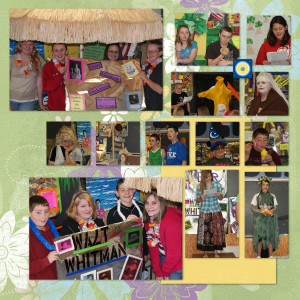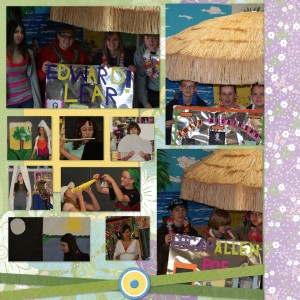Baobabs
What bad habits or small problems can you think of that need to be taken care of while they are little? (problems in friendships, getting behind in schoolwork, etc.) List the “baobabs” of our planet and/or country. How would you uproot them? What things in today’s society might be the roots of “baobabs” to come?
Our quick write for today led perfectly into our review of the first seven chapters of The Little Prince. After several students sharing their own quick writes and some lively discussion about the problems or habits that we all have that are easier to fix before they become big issues, we began looking at the following literary elements of the book.
POINT OF VIEW • The narrator gives a first-person account, although he spends large portions of the story recounting the little prince’s own story of his travels.
SETTINGS (PLACE) • The Sahara Desert and outer space. (TIME) • “Six years ago,” although the current date is never specified we are able to determin that it is sometime after the invention of air planes. The book is not set in a particular period or in one specific place. In the first chapter the narrator writes about his childhood experiences with drawings and about his low opinion of adults. In the second chapter the narrator starts narrating a particular series of incidents. He writes of the time when his plane crashed in the desert of Sahara six years ago. Most of the narrative after the second chapter is set in the desert. The other places that function as settings include the asteroid where the Little Prince has his home and the planets that the Little Prince visits, including asteroids 325, 326, 327, 328, 329, and 330. The last planet that he visits is the Earth, where he meets the narrator in the Sahara Desert. The story is really about the narrator’s friendship with the Little Prince and about the Prince’s own quest, which takes him to seven planets apart from his own.
Characters
The narrator is really the author, Antoine de Saint-Exupéry. The reader hears his voice throughout the book as he relates the story of the Little Prince and of his own friendship with him. The narrator says plainly that he is a romantic who does not like adults, whom he finds too practical; instead, he prefers children, whom he finds natural and delightful. The narrator writes this story of his encounter with the Little Prince in order to deal with the sorrow of losing his precious friend. A lonely pilot who, while stranded in the desert, befriends the little prince. They spend eight days together in the desert before the little prince returns to his home planet. Although he is discouraged from drawing early in his life because adults cannot understand his drawings, the narrator illustrates his own story and makes several drawings for the little prince. The narrator is a grown-up, but his view of the world is more like a child’s than an adult’s. After the little prince departs, the narrator feels both refreshed and saddened.
The Little Prince The novel is named after the Little Prince, who is a mystical and loveable person. He is the sole inhabitant of a small planet, which the narrator refers to as B-612. The Prince leaves his planet to visit other places and finally lands on Earth. In the Sahara Desert, he meets the narrator and befriends him. The narrator tells of his encounter with the Prince and also relates the adventures of the Prince on the other asteroids that the latter has visited. One of the two protagonists of the story. After leaving his home planet and his beloved rose, the prince journeys around the universe, ending up on Earth. Frequently perplexed by the behavior of grown-ups, the prince symbolizes the hope, love, innocence, and insight of childhood that lie dormant in all of us. Though the prince is sociable and meets a number of characters as he travels, he never stops loving and missing the rose on his home planet.
The Turkish Astronomer The narrator mentions the Turkish astronomer in the fourth chapter. The narrator believes that the planet from which the Little Prince has come is the asteroid known as B-612. A Turkish astronomer first sees this asteroid through the telescope in 1909. The first human to discover the prince’s home, Asteroid B-612. When the Turkish astronomer first presents his discovery, no one believes him on account of his Turkish costume. Years later, he makes the same presentation wearing Western clothes, and his discovery is well received. The scientific community’s treatment of the Turkish astronomer reveals how what someone wears or looks like has an affect on whether people will believe them or not.
The Little Prince’s flower or The Rose On the Little Prince’s planet, the flowers are usually very simple; but one day, from a seed blown from afar, a new flower comes up that is very beautiful, but also very vain or conceited. The Prince begins to doubt the flower’s credibility and finally leaves his planet to escape the company of the flower. A coquettish flower who has trouble expressing her love for the little prince and consequently drives him away. Simultaneously vain and naïve, she informs the little prince of her love for him too late to persuade him to stay home and not to travel. Throughout the story, she occupies the prince’s thoughts and heart.
Baobabs, harmless trees on Earth, pose a great threat to smaller planets like the prince’s if left unchecked. They can squeeze whole planets to pieces with their roots. Although baobabs have no malicious opinions or intentions, they represent the grave danger that can befall people who are too lazy or indifferent to keep a wary eye on the world around them.
Elements of Plot We have been use to just doing a plot summary on our AR summary forms, but next year our 8th grade AR summaries require us to break down the books we have read into the specific elements of the plot. We will need to know the exposition or introduction of the conflict, the rising action, climax, falling action and the resolution. This is something that we should be aware of as we read the book, but may not be able to clearly identify until we have finished reading the book.

